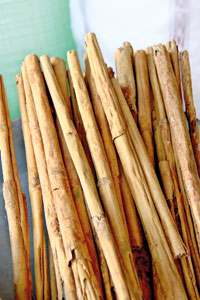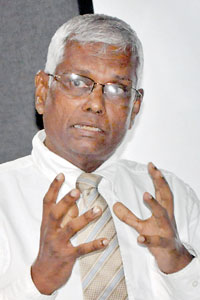News
Cinnamon: From exotic to curative
View(s):For the first time in Sri Lanka, the health benefits of this spice are coming under the microscope in  a comprehensive, multi-centre scientific study. Kumudini Hettiarachchi reports

The spice that has attracted much attention from east and west to this teardrop island aeons ago. Pix by Nilan Maligaspe and Indika Handuwala
He was heavily into tea before but now he has turned his sights on something which attracted much attention from east and west to this teardrop island aeons ago.
Spices they came in search of to Ceylon in the Old World amongst which was the much-sought after cinnamon or kurundu. These days, housewives break off pieces of this spice and stir into steaming curries to get that extra zest, without a second thought.
The team from the Sri Jayewardenepura University‚Äôs Interdisciplinary Centre for Innovation in Biotechnology & Neuroscience, Faculty of Medical Sciences headed by Director Prof. Ranil de Silva is, however, looking at a different aspect ‚Äď the health benefits of cinnamon.
‚ÄúCinnamon is a multifaceted medicinal plant which primarily contains vital oils and other derivatives. It has antioxidant, anti-inflammatory, anti-diabetic, anti-microbial, anti-cancer, lipid-lowering, cardiovascular-disease-lowering properties and also acts against neurological disorders, such as Parkinson‚Äôs and Alzheimer‚Äôs diseases,‚ÄĚ says Prof. de Silva.
This is why cinnamon is under the microscope in a comprehensive, multi-centre scientific study ever undertaken in Sri Lanka by a multidisciplinary team comprising scientific and medical researchers from the Sri Jayewardenepura University’s Faculties of Medical Sciences, Applied Sciences, Management Studies and Technology; the Kelaniya University’s Faculty of Science; and the Colombo University’s Institute of Indigenous Medicine.

Prof. Ranil de Silva at Thursday’s meeting
The Department of Export Agriculture, Peradeniya, is also part of the programme, while the team has won a competitive research grant to the value of Rs. 27.7 million to study the ‚ÄėPotential protective roles of Ceylon Cinnamon in health, leading to product development‚Äô from the Primary Industries Ministry.
From across the seas, international collaboration and funding are being extended by Japan’s National Institute of Advanced Industrial Science and Technology (AIST), the 7th innovation centre in the world, along with India’s Department of Bio Technology (DBT) under the Science and Technology Ministry; the European Graduate School of Neuroscience (EURON); America’s George Washington University; Sweden’s Gothenburg University; and Australia’s Queensland University of Technology.
Pointing out that Sri Lanka is the only country exporting authentic cinnamon, Prof. de Silva reiterates, however, that there is no significant value-addition to cinnamon products manufactured at grassroots level. The popular export products are in the form of quills, with quality mainly being decided by importers to match their quality standards. Thus the actual economic value of cinnamon cannot be evaluated.
Getting down to detail, he says that cinnamon is one of the oldest spices used in traditional medicine and while about 250 species have been identified so far, it is just four that are used to obtain the spice. True or Ceylon Cinnamon (Cinnamomum verum or C. zeylanicum) is a small evergreen tree native to Sri Lanka which produces the highest-grade pure cinnamon, while the Chinese cassia cinnamon (Cinnamomum cassia) is the other most widely available species.
With its distinctive flavour and aroma, cinnamon is not only used as a food ingredient in bakery products, Asian foods, desserts, spicy candies, hot cocoa, liqueurs and tea but also in pharmaceutical preparations and the cosmetic industry. It is a common ingredient in various products such as lipstick, toothpaste, mouthwash, chewing gum, soap, nasal sprays and cough syrups.
‚ÄúSri Lanka is the world’s largest producer and exporter of pure cinnamon and pure Ceylon Cinnamon suppliers have around 70% of the global market-share,‚ÄĚ says Prof. de Silva, adding, however, that export earnings from cinnamon have stagnated in recent years.
Ceylon Cinnamon is categorised into four major grades — Alba, Continental, Mexican and Hamburg based on the diameter of the quill and the most expensive (Alba) quill has a six-mm diameter.
Prof. de Silva’s contention is that with value-additions, especially considering its potential health benefits, cinnamon could be exported in the form of oil, powder and tablets, bringing in more foreign exchange to the country.
| Cinnamon exporters, academics and researchers meet On another front, in a major effort to link academia and industry through cinnamon, Prof. Ranil de Silva organised a meeting of minds on Thursday, in collaboration with the Director of Agriculture of the Export Development Board, Malani Baddegamage. With academics cum researchers from the Sri Jayewardenepura and Kelaniya Universities sitting down with Ceylon Cinnamon exporters, the discussions ranged from quality to branding to value-addition. Prof. de Silva points out although the largest true cinnamon exporter in the world is Sri Lanka, regrettably Ceylon Cinnamon exports are threatened by low-quality Cassia, a cheap substitute. He informed the group about the major research project undertaken to support the manufacture of innovative herbal/natural products from Ceylon Cinnamon based on scientific evidence. It will enhance global marketability, while patents could also be obtained on value-added cinnamon products. | |
| Bioactive compounds to battle CVD? Picking up key bioactive compounds found in cinnamon, Prof. Ranil de Silva and his team are hoping to get an insight into cinnamon‚Äôs effects on numerous non-communicable diseases such as cardiovascular disease (CVD), diabetes, cancer, neuro-degeneration and oxidative stress. CVDis the leading cause of death worldwide with many succumbing to heart attacks or strokes, he says, explaining that cinnamon has demonstrated therapeutic properties in studies both in-vitro (outside) and in-vivo (inside) linked to animals and humans. With hypertension or high blood pressure a major risk factor for CVD, he quotes a recent meta-analysis of randomized, placebo-controlled clinical trials which reported that cinnamon supplementation (1.2 g/d to 10 g/d) in subjects with pre-diabetes or type 2 diabetes resulted in significant decreases in the SBP or systolic blood pressure (-5.39 mm HG) and DBP or diastolic blood pressure (-2.6 mm Hg), on average. Referring to neuro-degenerative diseases such as Alzheimer‚Äôs Disease (AD), Parkinson‚Äôs Disease (PD), Amyotrophic Lateral Sclerosis, Huntington‚Äôs Disease and Friedreich‚Äôs ataxia which are devastating age-related conditions, Prof. de Silva whose pet subject is the brain, points out that currently, their aetiology remains largely unknown. The available treatment options are unable to slow, reverse or cure the underlying neuro-degeneration and the natural course of the disease. ‚ÄúPresent medications only address single pathologies that manifest as a result of neuro-degeneration and are associated with many side-effects. As such, there is a critical need for safe and effective therapies to prevent or slow the progression of disease,‚ÄĚ he says. One of the oldest spices used in traditional medicine, cinnamon has shown that it can modulate multiple mechanisms involved in neuro-degeneration. In-vivo, cinnamon has shown that it can reduce oxidative stress and neuro-inflammation, while reducing A aggregation and improving cognitive function in an AD mouse model. This is why Prof. de Silva and his team are now bent on looking closely at cinnamon. | |

